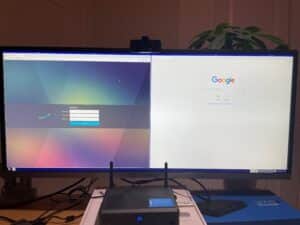GUEST BLOG – By Omar Kechrid – VP of Business Development at ZeeTim
Read about how the testing experience from one of Azulle’s top customers.

Recently, I had the pleasure of testing out the Byte mini desktop PC from Azulle, the award-winning mini PC manufacturer. The idea was to run some tests with our ZeeOS operating system and see how the Byte performed in a virtual workspace setup. I was thoroughly impressed by the quality and performance of this device. This was the perfect hardware to complement ZeeTim’s Thin Client replacement solution and surely can prove to be a device that can withstand the test of time. Together, the Azulle Byte along with ZeeTim’s endpoint software make up an ideal solution for any organization running virtual workspaces and looking to make endpoints immune to cybersecurity attacks, and easier to manage from anywhere.

When I first received the Byte, I found the packaging to be very modern and it reminded me of the experience of opening an iPhone. Then, when I saw the computer hardware I found a quality device that felt extremely solid with a sleek and modern design. I could immediately picture this hanging in a very clean way on the back of a monitor with a Vesa mount. The device I tested had an Intel Celeron quad-core processor which could compete with any of the mid to high-end thin client options in the market today. It also offered a large variety of ports that could be required. This included 4 USB 3.0 ports, a USB c port, a micro SD port, a POE port, an RJ45 port, audio/mic, as well as VGA, DVI, and HDMI ports. The device comes pre-built with Windows and I can see why many customers looking for a Mini PC see the huge value of the Byte mini desktop PC. While my testing was only focused on accessing a virtual workspace, the Byte can be built with even more powerful processors (i3, i5, and i7). In my case, it would be overkill to go for these higher processors, making no economic sense for a VDI project.
Further into my testing, I replaced the existing Windows operating system on the Byte and loaded it with ZeeTim’s ultra-secure and lightweight ZeeOS operating system, which is purpose-built for virtual workspace offerings (i.e. Citrix, VMware Horizon, Microsoft RDS or AVD, Nutanix Frame, Amazon Workspaces, and others). The process to do so is very simple and is done via the ZeeTransformer tool. You simply download ZeeTransformer and run the program with a USB (minimum 8GB in size) inserted. The program formats the USB drive and loads it with ZeeOS in about 15 minutes. Once complete, the USB is automatically ejected and ready to boot from. If you’ve created the USB on a separate computer, you would take the USB, insert it into the Byte, go into the BIOS, and set the boot sequence to boot from the USB as I did during testing. However, ZeeTim does offer the option to completely flash the hard drive and install ZeeOS directly onto the Byte. ZeeOS booted very quickly, and I entered the ZeeOS desktop.

I then went on to install the ZeeConf management tool allowing me to configure the device based on my needs. Due to security measures, configuration on ZeeTim cannot be made locally on the device and must be done from ZeeConf. ZeeConf allows devices to be set up in “Zero Touch” mode. I tested the endpoint with both Thin Client and Zero Client modes. In Thin Client Mode, the OS presents a traditional desktop with multiple apps (i.e. Firefox, Chrome, Citrix Workspace Client, VMware Horizon client, etc…) with a desktop and taskbar. In contrast, Zero Client mode sets up the device to run only one application in a full professional kiosk systems mode. For example, if all I want to do is run Citrix and I only have one virtual workspace instance to connect to, then Kiosk mode is the most simple option for the user. I tested both Thin Client and Zero Client modes with Citrix, VMware, and RDS and it worked like a charm! With ZeeConf I can also access and report on any device making support and maintenance very simple.

Within the virtual workspace, I ran 4K videos and was impressed with the smoothness of the image. The device would have no problem offering the highest level of graphics and a high refresh rate needed by more demanding applications. I tested a webcam, and it was immediately recognized without any issues. With ZeeOS installed, the Byte can provide great audio and video collaboration experience in virtual workspaces. In addition, you can also run Teams, Zoom, and multiple applications at a time smoothly.
If you are looking for Thin Client hardware, you should check out the Byte. Along with ZeeTim’s ZeeOS operating system and ZeeConf management software, this can make for a great solution. Both Azulle and ZeeTim have other interesting products that set them apart from the competition. Azulle offers PC sticks which can make for a great remote work solution, along with webcams, and PC remotes. ZeeTim ventures beyond the endpoint with a print optimization solution, as well as USB password vault and MFA solutions. It’s wonderful when two specialist vendors come together to offer a best-of-breed solution!
For more information on how to use ZeeTim software on Azulle mini PCs check out the below YouTube videos.
Azulle Byte, a great Thin Client hardware – https://youtu.be/lS9GWno5G60
Installing ZeeOS from ZeeTim on the Azulle Byte- https://youtu.be/NLS8Dmu0KE4
To learn more about ZeeTim visit www.zeetim.com





